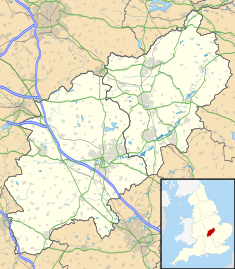A major contributor to this article appears to have a close connection with its subject. (January 2024) |
| Apethorpe Palace | |||||||||||||||||||||||||||||||||
|---|---|---|---|---|---|---|---|---|---|---|---|---|---|---|---|---|---|---|---|---|---|---|---|---|---|---|---|---|---|---|---|---|---|
| Formerly Apethorpe Hall | |||||||||||||||||||||||||||||||||
 Apethorpe Palace south elevation
| |||||||||||||||||||||||||||||||||
| |||||||||||||||||||||||||||||||||
Apethorpe Palace (pronounced Ap-thorp), formerly known as "Apethorpe Hall", is a Grade I listed[1] country house, dating to the 15th century, close to Apethorpe, Northamptonshire. It was a "favourite royal residence" for James I.[2]
The house is acknowledged as one of the finest remaining examples of a Jacobean stately home[3] and one of Britain's ten best palaces.[4] It holds a particular importance due to its ownership by, and role in entertaining, Tudor and Stuart monarchs; Elizabeth I inherited the estate from her father Henry VIII and her successor, James I, personally contributed to its 1622 extension, housing the state rooms and featuring some of the most important surviving plasterwork and fireplaces of the period.[5] There were at least thirteen extended royal visits – more than to any other house in the county – between 1566 and 1636,[6] and it was at Apethorpe, in August 1614, that King James met his favourite and speculated lover, George Villiers, later to become Duke of Buckingham.[7][6] A series of court masques written by Ben Jonson for James I were performed while the King was in residence at Apethorpe.[8][9] The house was also lived in regularly by Charles I.[2]
- ^ Historic England. "Apethorpe Palace Formerly Known As Apethorpe Hall (1040083)". National Heritage List for England. Retrieved 10 September 2023.
- ^ a b "Apethorpe Palace". English Heritage. Archived from the original on 26 May 2016. Retrieved 12 May 2016.
- ^ Gaches, Philip (2008). "Apethorpe Hall's Jacobean Ceilings". www.buildingconservation.com. Retrieved 12 September 2023.
- ^ "Britain's 10 best palaces".
- ^ "Historic England – Championing England's heritage | Historic England". English-heritage.org.uk. Retrieved 12 May 2016.
- ^ a b "Historic England – Championing England's heritage | Historic England". English-heritage.org.uk. Archived from the original on 3 December 2014. Retrieved 12 May 2016.
- ^ Kathryn A. Morrison, Apethorpe (Yale, 2016), 92.
- ^ "The progresses, processions, and magnificent festivities, of King James the First, his royal consort, family, and court : collected from original MSS., scarce pamphlets, corporation records, parochials registers, &c., &c : Nichols, John, 1745–1826 : Free Download & Streaming : Internet Archive". Archive.org. Retrieved 12 May 2016.
- ^ E. K. Chambers, The Elizabethan Stage (1923) vol. IV, 83
